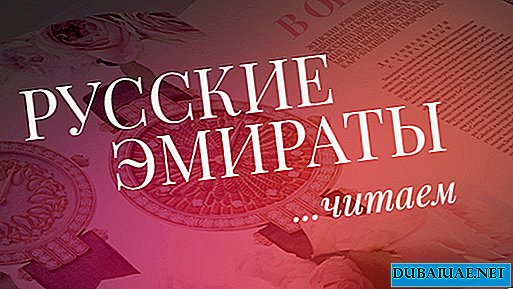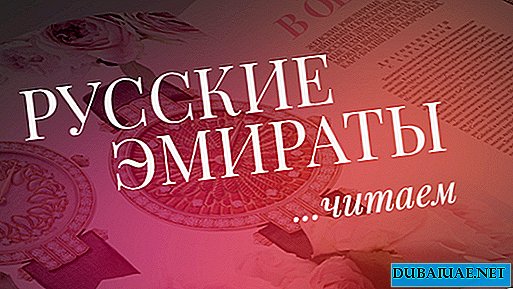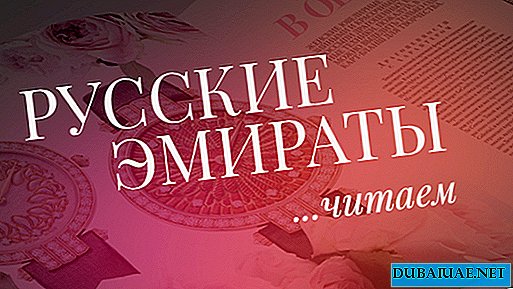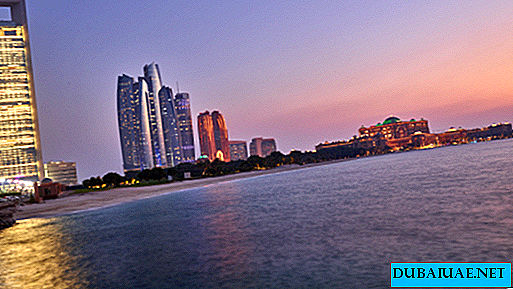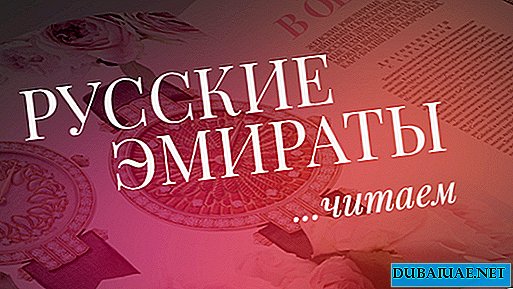As soon as dawn broke, my car was already rushing towards the Nad al-Sheba racetrack, where I was promised something amazing and unforgettable. Having passed camel farms with impressive ships of the desert, slowly preparing for the daily 20-kilometer training race, I drive up to a roundabout, on the flowerbed of which the greeting “Welcome to Dubai!” Is planted with white flowers, and I see the darkest stands of the hippodrome.
Doubt creeps in, and didn’t I confuse what, when I accepted the invitation by phone to arrive at 7.00? Maybe by seven in the evening, and not in the morning? But then I notice that one car passes by me, then the second ... I move right behind them and park in the parking lot of the Nad Al-Sheba Golf Club. It has already dawned in order, and everything around does not seem so sleepy and deserted: employees put things in order on the territory, check the serviceability of watering sprays, and adjust the golf cart to a certain place. At the door of each newly arrived guest, ex-jockey Mike greets them and invites them to a cup of coffee, which helps to pass the waiting time before the start of a four-hour tour of the huge Nad al-Sheba complex. I walk around, look around: the club has a restaurant, a bar and a store with clothes and accessories for playing golf. The restaurant is already undergoing some preparations. And the guests keep coming.
At 7 o’clock in the morning all those present are invited to go out into the fresh air, closer to the racetracks of the hippodrome. The breeze is about cool, and people cringe under its pores by you. Mike gives statistical information about the construction of this gigantic complex, about the world's largest prize pool of races, about the length of the track and the number of private and general stables. At this time, the horses are taken out for training races, and the jockeys demonstrate to the audience, frozen with delight, what these graceful animals are capable of. They jump at a trot, go to a gallop, increase speed, reduce it, prank sideways in front of viewers. In the rays of the dawn sun, horses and riders sweep in pairs, threes and alone, raising wet sand, and on this side of the fence, photos and video cameras work together, shooting their rapid run.
Mike offers to continue the tour by bus, and we set off to look at the life of horses from the inside, so to speak, behind the scenes, and to be more precise, the buses take us to the stables. We pass the pinkish arch with a clock and a green alley leading inside, because the entrance is closed to Sheikh Maktoum's private stables. Private stables contain 140 tribal horses, multiple winners of world horse races. Here they are looked after, as for their beloved wives. The buses turn to the general stables, after visiting which I deeply thought that if animals are cared for and cherished in eight other stables, then what other supernatural care do the sheikh’s horses take? Before entering, we receive strict instructions - do not feed horses if the corral door is open, do not approach the animal, and when the horse is led to the corral or taken out of the corral, you should press against the wall on the right or left side! As we listen to Mike, we notice that a huge dog, looking like a German shepherd with a chopped tail, runs out of the gates of the stable and heads towards us. “Don't be afraid, this is the audience’s favorite and the friendliest dog in the world!” Says Mike. But everyone already understood this, because the dog, having run up to the standing tourists, seeps into the very center of the group and begins its acquaintance without missing a single person. He pokes his nose into his knees, substituting his frontal head under his hands, so that he is urgently stroked, and rubs his legs. Most of all he is attracted to children, who are also delighted with the dog, and immediately start a fun fuss. The story of the appearance of this dog in the stables is as follows. Once the horse trainer found the sheikh who was riding in the stables drowning in sorrow. Asked about the reason, he heard in response that the sheikh had died a beloved dog. A few hours later, the sheikh was about to leave and, going up to his car, found a touching puppy in the passenger seat. So the puppy began to grow together with the famous horses, caressed by the love and attention of all the inhabitants, workers and visitors of the Godolfin stables. Due to the outward resemblance to a gray predator, he was nicknamed Wolf.
At the entrance we were surrounded by a smell characteristic of all stables, and I was glad that there was nothing else in the stomach besides coffee. Fresh wooden sawdust was generously sprinkled on the floor of each stall or newspaper scraps scattered daily updated. On each pen is a sign indicating the name of the horse, the country from which it was brought, and the name of its current owner. The open stables contain trotters - participants in horse racing in the desert. They are tempered by winds and heat, so even a night's rest for them is provided in the open air. The morning exercise of the stables inhabitants consists of a training race, a refreshing shower and breakfast, the menu of which is developed in a special scientific laboratory. To improve blood circulation and lower blood pressure in the legs of the steed, from the ankle to the ankle for several minutes, a “boot” is applied - a special ice compress. Then, a hairdresser combing the horses' manes and tails, and the winds of the bunks, make their rounds. Particularly careful monitoring is carried out for animals that are directly involved in the races of this season and are potential contenders for victory. Crowed, pied, brown, and crunched horses shine as if polished, cannot stand still, nervously fingering with thin long legs, snort and nod their heads. It is amazing that these proud beauties from ancient times obey and serve man!
We return to the restaurant of the golf club, where we are already waiting for breakfast in the traditional English style - a glass of freshly squeezed orange juice, scrambled eggs with bacon, toast with jam, yoghurts and coffee. During breakfast, a movie about the life of the hippodrome with the comments of Sheikh Mohammed bin Rashid Al-Maktoum, the current ruler of Dubai and the vice-president of the UAE, is shown on large television screens.
Now we have the culmination of the tour - a visit to the jockey rooms, the stands of the hippodrome and the Godolfin Gallery. The whole group takes places in a number of golf carts parked in a row (special golf carts) and sets off along winding paths to the main stands of the hippodrome. Here we see the form of jockeys of various teams, equipment and equipment, heavy tight belts with which jockeys lose weight on the eve of the competition, and learn about what tricks exist in the world of horse racing in order to “hold” or “hold” the favorite's horse and give step forward another bidder for a prize. For such tricks at international races in all countries of the world, jockeys with stallions are removed from the competition, disqualified for a certain time, but all the same, where huge prize money takes place, there will always be “negotiable” winners. In Dubai, tote games are forbidden, but each spectator can fill out a lottery ticket, and if he guesses all the numbers of the winning horses of all the races, he can win a prize of 50 thousand dollars.
The Godolfin Gallery tells the story of the origin of tribal Arabian horses, the world winners of international horse racing competitions. Just 12 years ago, the first international horse racing championship was held in Dubai, which proved that tribal horses, descendants of the legendary stallion named Godolfin, will delight with their victories for more than a century.
The tribal suit "Arabian Godolfin" was bred in Yemen in 1724 from Dzhilfinskoy blood. The bay foal with a small white spot on the inside of the ankle was 14.3 palm high at the withers. Together with three other tribal stallions, he was exported through Syria to Tunisia. Trinity was sold to Britain to improve the local breed. And the governor of Tunisia presented the fourth foal from the “Godolfins” nicknamed Chamy to the king of France, where he expected a very unenviable fate - to drag the royal carriage through the streets of Paris. Fortunately, the six-year-old stallion was noticed in Paris by the Englishman Edward Kock, bought it for 3 pounds and sent him to the Lonford Hall farm. When Edward Kock died in August 1733 at the age of 32, the tribal suit passed to the owner of the Coffee House in London, Roger Williams, who renamed Shamy to Francis II, Earl of Godolfin. It was this Godolfin who was prepared to participate in the races, in eight of which he became the winner, the most famous were the victories in 1738, 1745 and 1747. The Arab Godolfin died in the town of Gog-Magog, near Cambridge, in December 1753 at the age of 29 years. His numerous offspring, sold in different countries of the world, and to this day amaze connoisseurs and lovers of racing with their speed qualities.
The first international hippodrome in the UAE with horses whose breeding blood was collected all over the world was organized in 1993 at Al Quoz in Dubai, but existed there for only a few years, because in a short period a new one was rebuilt in Nad Al Sheba a gigantic complex with modern stables that meet all international standards, where the team called Godolfin moved.
The Godolfin Gallery leads along the corridors of the history of prizes, gifts, filmography, cups ... The exhibition dedicated to the most famous one, which brought victory in 9 out of 10 races, to the horse named Dubai Millennium, is one of the most interesting and memorable. A wax figure donated to the Madame Tussauds Godolfin Gallery captures the moment when a stallion with his rider Frankie Dettori crosses the finish line and becomes a full-fledged World Cup 2000 horse racing. This stallion was loved by the private stables of Sheikh Muhammad Rukhamed Al-Maktoum, and in honor of the historic victory in the millennium, it was renamed from Yaaser to Dubai Millennium.
Since 1996, the racers have won the Dubai World Cup: Cigar (1996), Singspiel (1997), Silver Charm (1998), Almutawakel (1999), Dubai Millennium (2000), Captain Steve (2001), Street Cry (2002) , Moon Ballad (2003), Pleasantly Prefect (2004), Roses In May (2005), Electrocutionist (2006) and this year's winner is Invasor.
The annual Dubai International Racing Carnival this year kicked off in Nad al-Sheba on January 18, 2007 with a sheer prize fund of Sheikh Maktum bin Rashid Al Maktoum in the first round. With a total prize pool of $ 31 million in 11 races, the Dubai International Horse Racing Festival is the most expensive Championship for this type of dispute in the world. During the festival, there are also a lot of glamorous events, which include such popular holidays as Fillies & Fashions and Family Day. And on the final holiday on March 31, as part of the final race at the World Cup in horse racing with a prize pool of $ 6 million, opening with a unique spectacular gala concert and fireworks, a show of women's hats and a contest for the most beautifully dressed lady and the most elegant couple whose winners receive great prizes and gifts. The Dubai World Cup in horse racing is a combination of sports, luxury, harmony, beauty and grace.
/ Elena Balina /



